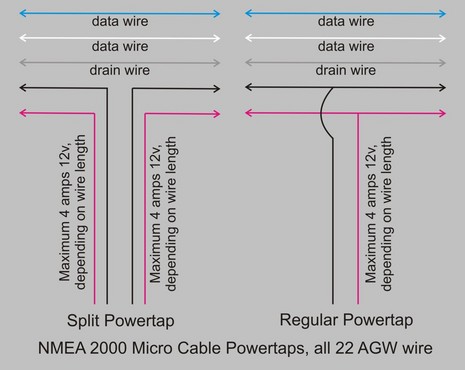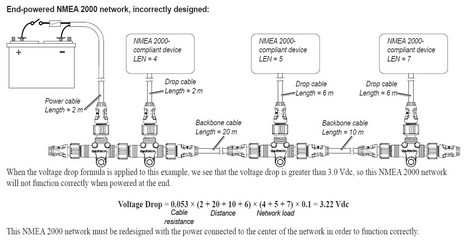NMEA 2000, power "problem" part 2

I think I got this diagram right, and I think it's important to understand if your boat might end up with more than a few NMEA 2000 powered devices on its network. As discussed on Monday, the popular 'light' (or Micro) size NMEA cables only contain 22 AWG power (and data) wires. Its well insulated power wires are apparently perfectly safe (despite some internecine standards organization hubbub on that score) but they simply can not carry much DC juice very far. Electrical resistance is dependent on wire size -- DC especially so (hence the fascinating "War of Currents") -- and the few DC wire tables that even include 22 guage don't look good. Which is why some manuals, like Garmin's below, go to some trouble regarding powertap placement...
A split powertap can also be used to feed a third leg of a N2K backbone (with the wire pair headed toward the already powered leg taped off), as long as all taps are led to a common ground. That could be especially useful if you want to add something and realize you don't have the proper juice available. But isn't smarter to start with all the backbone power you can reasonably fit and afford? While 8-amp-per-leg Mini size NMEA cable is almost as thick as a garden hose, and very expensive, it looks like Maretron's Mid size cable, which has regular Micro connectors, wouldn't add a shocking cost to a backbone, if any. (Here's a quick Google comparison: Maretron 10 meter Mid vs Garmin 10 meter vs SimNet 10 meter vs SeaTalkNG 5 meter backbone). Mid is only rated for 4 amps, like regular light cable, but its 16 AWG power wires result in much less resistance (4 Ohms versus 18 for micro wire) and hence much friendlier voltage drop calculations. Even on a small boat, a split powertap located near the load center of the backbone seems like obvious and relatively cheap future proofing.


 Share
Share
Ben,
The original Devicenet specification called for 22 Gauge Power cores in Micro cables. The original cable designers mainly considered small, milli-amp draw sensors in factory automation systems for Micro cables.
During development meetings, we intentionally chose to only offer 18 Gauge Power wires, or larger, in our NMEA2000 Micro Cables to avoid the very problem you are describing, since marine industry sensors would necessarily be more power hungry. At least one other major partner agreed and followed.
Indeed, the cost, cable diameter, and weight savings of a 22Ga twisted pair vs. a 18Ga twisted pair for power in a NMEA2000 Micro cable is neglible in the maritime market.
Check the NMEA2000 Micro cable specifications of all the major manufacturer's NMEA2000 Micro Cables to see what I mean.
Insider